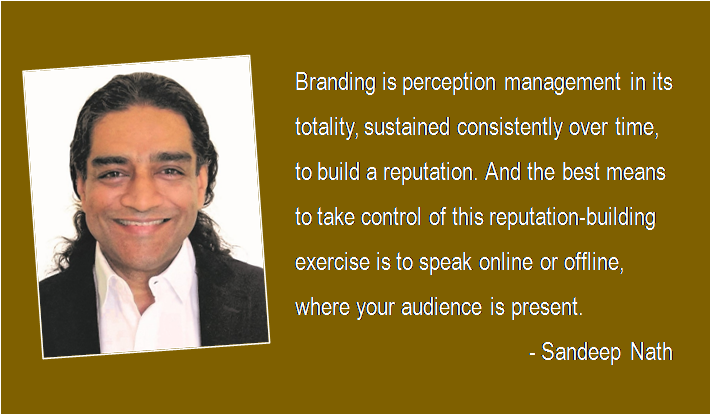All professionals seeking to brand themselves – be they lawyers, doctors, architects, trainers, coaches, or whatever – must realise that branding is not about logos, advertisements, and social media profiling. Branding is perception management in its totality, sustained consistently over time, to build a reputation. And the best means to take control of this reputation-building exercise is to speak online or offline, where your audience is present. Doing so builds trust, clarifies your expertise, increases audience-involvement with you, and thus brands you – even without a logo!
So here are five steps I recommend to start off as a speaker, especially nowadays that the CoViD is giving us more time for self-development.
- Get your message: We all have a message inside us. Sometimes we think it is similar to the messages we listen to. And sometimes we know it is radically different, which is excellent. Even if you feel you have nothing new to add, you always have personal experiences, which mould your message uniquely. Add to these experiences a layer of your thinking, and you will arrive at messages with a radically new twist. This is all it takes. But this is the basis of everything it takes. You have to formulate your core message. And make it as specialised and helpful as possible; to the extent that you can describe what problem you solve in less than ten seconds.
- Get a camera: These days almost every phone has one, so this is easy. What is not as easy is to get the camera in front of ourselves and speak some part of our message out. This is why step 2 is important. When you do this, it will probably be the first time you see yourself speaking. And chances are you will immediately start to judge yourself. That is not the idea. The idea is to see your eyes, your lips, and hear your sound. Pay attention to the visual and audio tones and make them friendly, like when you speak with kids. Imagining kids in your audience (behind the camera) will help simplify your message as well. And you will have zero stage fright when step 1 is clear, and step 2 is practiced; who is ever afraid to speak to kids?
- Read up stories: The trick to engage audiences is to blend our messages with stories. Often, we don’t have all the stories in our personal repertoire of experiences, so reading them up and integrating them with our messages is a great option. Stories are learning tools – which is why we tell them to kids – for our messages to penetrate deep. On the other hand, jokes are mood-switchers. Too many speakers rely on jokes, which, unless well-delivered and peppered, stick out like silly comedy tracks in cheap south-Indian films. Stories always mix better; the point is to read them even if we have our own because that helps to style our message well.
- Seek out opportunities: Now, this is where the legwork comes in, though the Internet is a great help. What we have to be looking for are events around us which we can attend, to acquaint ourselves with the organisers for consideration in their future events. Meanwhile, as you develop comfort with the camera, start putting up stuff on Youtube, Instagram, and TikTok. These three sites tend to go viral with good content, so opportunities might come looking for you if steps 1, 2, and 3 are continuously refined. Besides, with the CoViD around us, garnering an internet audience is a fantastic starting point.
- Get professionally trained: Once you have spoken at about 20 centers or conducted 20 webcasts, you would have clarity at all levels – body, mind, and spirit – and would be ready to invest in yourself. Find a professional, maybe through the Professional Speakers Association of India, who you pay to guide you to produce material and develop methodologies that market you for a fee. Professional speakers in India earn several lakhs per engagement, depending on the depth of their specialty.
Yes, step 5 is optional and desirable only for speakers who want to take their reputation to the next level. Most people gain great satisfaction by step 4, and many do by step 1 itself! By step 1, you ask!? Yes! Because that exercise alone brings about immense clarity of one’s purpose, which reduces stress, increases happiness, and improves well-being. ‘The 5 levels of Purpose’ are covered in another article right here. Enjoy reading!
The views and opinions published here belong to the author and do not necessarily reflect the views and opinions of the publisher.



Awesome steps Sandeep. This article has been quite a revelation and gives me action steps for the commute time I am saving these days! Thanks!